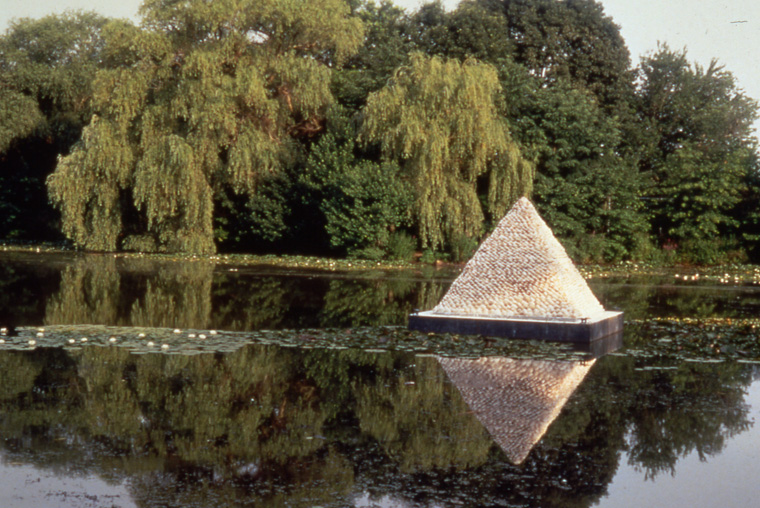Floating Pyramid for a Consideration of Cultural Notions of Wealth and Value
Convergence, Roger Williams Park, Providence, Rhode Island, 1995, 3,000 clam shells, wood, steel, cement; steel float - 12 x 12 x 2' ; pyramid - 10 x10 x 8'
One of the things that interested me about Providence and Rhode Island as early habitation sites along the eastern seaboard was wampum. Wampum is officially defined as "strings of white and purple beads...made by grinding and drilling the shells of whelks and quahogs until they were hollow cylinders a quarter of an inch." (Cronon, Changes in the Land) It gave me pause that shell could form the basis for monetary currency; it seemed so foreign to our current sense of money and exchange. A material secreted by a humble mollusk, picked up anywhere along the beach or left over from a meal - this seemed at first glance an entirely unlikely source for currency. At least one key to this apparent enigma seemed the intense labor involved in transforming common shell to wampum.
I read that the "Narragansetts sold their land for 720,000 white beads" (Simmons and Porter, Indians of North America: The Narragansett) and I wondered what that amount of wampum most have looked like. Surprisingly, there was a short time period when Native Americans and Europeans both used wampum and, not surprisingly, they brought different ideas to its use. "To the Narragansetts, the use of wampum might symbolize and affirm an ancient and continuing idea of social obligation and reciprocity (italics mine), to the Europeans the beads simply facilitated a transaction, one that might bring financial gain...The use of shell and shell beads in ceremony is ancient...Marine shell itself has had (connotations) of spiritual and social well-being...and when properly consecrated would help assure the well-being of individuals and communities." (Rhode Island Historical Society, What a Difference a Bay Makes, Robinson, "The Wampum Trade in the 17th Century Narragansett Country"). I became interested in shell as an indigenous material that facilitated trade in this locale in the pre-colonial era and still functions in this realm today in the seafood industry.
The pyramidal form was selected for several reasons: it is formed of triangles much like the architecture of the shell itself, the pyramid appears on our dollar bills and is a symbolic form of transcendence in many world cultures. In the study of economics there is a complex triadic theory regarding property rights. According to Huntington Cairns, if an individual (A) owns land (B) it is only valuable (beyond sustenance) if the community (C) grants A the right to "earn from its surplus." (Cronon, Changes in the Land) My reading also revealed "triangle trade" (Cronon) in colonial Rhode Island - molasses from the West Indies was made into rum in Rhode Island and traded for slaves in Africa. The European idea of property is then triadic in the sense that we define property according to who owns it, uses it, and profits from it. This is in opposition to the traditional indigenous view of land as less bounded and as more a source of sustenance than profit.
Thus the Floating Pyramid is tribute to shell and to human relationships with each other and the natural world.

